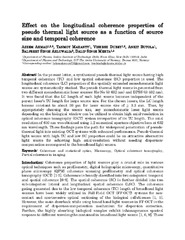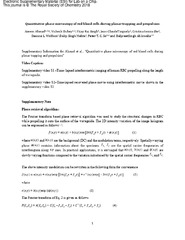Blar i forfatter "Dubey, Vishesh"
-
Effect on the longitudinal coherence properties of a pseudothermal light source as a function of source size and temporal coherence
Ahmad, Azeem; Mahanty, Tanmoy; Dubey, Vishesh; Butola, Ankit; Ahluwalia, Balpreet Singh; Mehta, Dalip Singh (Journal article; Tidsskriftartikkel; Peer reviewed, 2019-04-01)In the present Letter, a synthesized pseudothermal light source having high temporal coherence (TC) and low spatial coherence (SC) properties is used. The longitudinal coherence (LC) properties of the spatially extended monochromatic light source are systematically studied. The pseudothermal light source is generated from two different monochromatic laser sources: He–Ne (at 632 nm) and DPSS (at 532 ... -
High-throughput spatial sensitive quantitative phase microscopy using low spatial and high temporal coherent illumination
Ahmad, Azeem; Dubey, Vishesh; Jayakumar, Nikhil; Habib, Anowarul; Butola, Ankit; Nystad, Mona; Acharya, Ganesh; Basnet, Purusotam; Mehta, Dalip Singh; Ahluwalia, Balpreet Singh (Journal article; Tidsskriftartikkel; Peer reviewed, 2021-08-04)High space-bandwidth product with high spatial phase sensitivity is indispensable for a single-shot quantitative phase microscopy (QPM) system. It opens avenue for widespread applications of QPM in the field of biomedical imaging. Temporally low coherence light sources are implemented to achieve high spatial phase sensitivity in QPM at the cost of either reduced temporal resolution or smaller field ... -
Inflammatory response of macrophages and trophoblasts investigated using structured illumination microscopy and quantitative phase microscopy
Singh, Rajwinder; Wolfson, Deanna Lynn; Dubey, Vishesh; Ahmad, Azeem; Acharya, Ganesh; Mehta, Dalip Singh; Basnet, Purusotam; Ahluwalia, Balpreet Singh (Journal article; Tidsskriftartikkel; Peer reviewed, 2017-09)<i>Introduction</i>: The super-resolution capability of structured illumination microscopy (SIM) (100 nm) enables 3D imaging of mitochondria, and label-free quantitative phase microscopy (QPM) provides nanoscale quantitative phase values relating to cellular thickness and the refractive index of cellular content. -
Multi-modal chip-based fluorescence and quantitative phase microscopy for studying inflammation in macrophages
Dubey, Vishesh; Ahmad, Azeem; Singh, Rajwinder; Wolfson, Deanna; Basnet, Purusotam; Acharya, Ganesh; Mehta, Dalip Singh; Ahluwalia, Balpreet Singh (Journal article; Tidsskriftartikkel; Peer reviewed, 2018-07-24)Total internal reflection fluorescence (TIRF) microscopy benefits from high-sensitivity, low background noise, low photo-toxicity and high-contrast imaging of sub-cellular structures close to the membrane surface. Although, TIRF microscopy provides high-contrast imaging it does not provide quantitative information about morphological features of the biological cells. Here, we propose an integrated ... -
Quantitative assessment of morphology and sub-cellular changes in macrophages and trophoblasts during inflammation
Singh, Rajwinder; Dubey, Vishesh; Wolfson, Deanna; Ahmad, Azeem; Butola, Ankit; Acharya, Ganesh; Singh Mehta, Dalip; Basnet, Purusotam; Ahluwalia, Balpreet Singh (Journal article; Tidsskriftartikkel; Peer reviewed, 2020-06-12)In pregnancy during an inflammatory condition, macrophages present at the feto-maternal junction release an increased amount of nitric oxide (NO) and pro-inflammatory cytokines such as TNF-α and INF-γ, which can disturb the trophoblast functions and pregnancy outcome. Measurement of the cellular and sub-cellular morphological modifications associated with inflammatory responses are important in order ... -
Quantitative phase microscopy of red blood cells during planar trapping and propulsion
Ahmad, Azeem; Dubey, Vishesh; Singh, Vijay; Tinguely, Jean-Claude; Øie, Cristina Ionica; Wolfson, Deanna; Mehta, Dalip Singh; So, Peter T. C.; Ahluwalia, Balpreet Singh (Journal article; Tidsskriftartikkel; Peer reviewed, 2018-08-22)Red blood cells (RBCs) have the ability to undergo morphological deformations during microcirculation, such as changes in surface area, volume and sphericity. Optical waveguide trapping is suitable for trapping, propelling and deforming large cell populations along the length of the waveguide. Bright field microscopy employed with waveguide trapping does not provide quantitative information about ...


 English
English norsk
norsk




